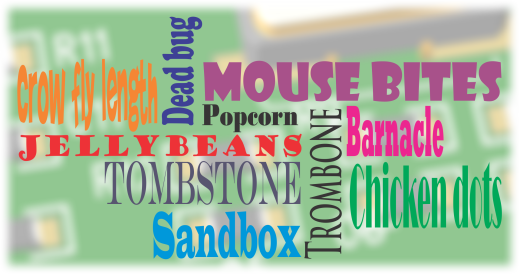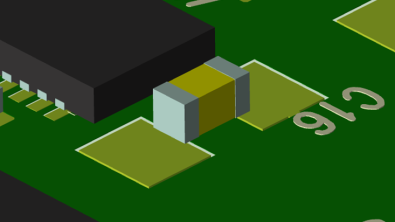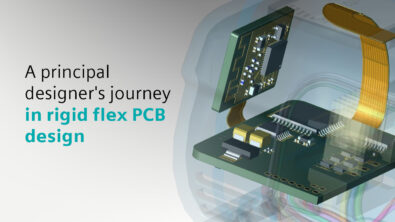Chicken Dots, Mouse Bites and Jellybeans
Folks that have been around PCB design for many years or just a few have used many terms and descriptions for different aspects and features of design. Through the evolution of PCB design from the light table to the advanced CAD tools we now use, terms like ruby (for rubylith) and Bishop Graphics (tape, dots and stick-on decals) are now old-school. In this blog I thought it would be fun to share some PCB design terms, slang, or anything unusual we have heard. Be sure to share yours to the comments below.

Mouse Bites – These are often an alternative to v-score for separating boards from panels. It is simply a number of drills that are close together on the board edge that creates a weak spot where the board(s) can be broken apart easily after fabrication. After the access board material or PCBs are broken off or apart, they leave what are often referred to as a “mouse bite” along the edge dots.
Chicken Dots – Typically seen in RF design, gold chicken dots give engineers something to stick ribbon bonds to. These artwork features do not affect the design, but facilitate tuning later. These were more commonly used before the accurate CAD tools came along are seen minimally today.
Crow Fly Length – Taken from the old saying “as the crow flies,” it is the shortest point-to-point connection as you see in the layout “rats nest” (hypotenuse of triangle). We typically design PCBs using the Manhattan length (sum of two sides of triangle) to optimize horizontal and vertical layer routing for designs.
Dead Bug – An oldie but a goody, this term applies most often when a through-hole chip was either pinned-out wrong or there is a component change. The part is de-soldered (or perhaps a new part) and it is glued upside down onto the PCB then wires are soldered from the legs to the appropriate connection points. The IC resembles a dead bug (picture a roach) flat on its back with its feet pointed up.
Jellybeans – This refers to components that are cheap like transistors, resistors, capacitors, diodes and made by lots of different manufacturers.
Popcorn – Another term commonly used for bulk resistors and capacitors. Today we refer to these commonplace, resistors, capacitors switches, and jumpers most often as passives.
Barnacle – Commonly used to describe a trace that has been cut, then a component like a resistor or capacitor that has been unexpectedly stuck/glued/soldered to the PCB, and then wires soldered to make connections. It has also been used to describe just a wire soldered from a cut trace to another point on the design. As you can imagine, barnacles are unexpected crustaceans for a PCB but not for the pylons on the beach pier. Even a complex sub-assembly or daughterboard may also be called barnacle by some.
Stuffed —Still common slang for a populated PCB with attached and soldered components. The opposite, unstuffed, is used to describe a PCB that has not had its components populated.
Spin – The process of laying out, routing, fabricating, populating, and testing a PC board. Each time a PCB must be revised and fabricated is typically called a”re-spin,” a term that isn’t limited to circuit boards or electronics. It is not uncommon to describe the first fab of a PCB as the “first spin,” even if nothing is re-done.
Matrix – Is a term used to describe an array or panelization of a PCB or PCBs, whichever seems to fit best. Most often “panel” is reserved for the standard-size laminate piece used by the PCB fabricator, whereas the word “panelization” indicates a method of designing an array of PCBs into a single processing piece for the PCB assembler.
More common but unusual terms:
Sandbox – Or sandboxes, usually carries a negative connotation. It refers to designers creating and using symbols or land patterns they’ve made and stored on their own, that is, outside of a component management system, not using their librarian, or a library flow they have created. The “sandbox” is typically the designer’s own bucket of parts created with a lack the oversight or the processes that an engineering design flow is put in place to avoid. Sandbox parts can create problems especially when they are not built correctly and can cost both time and money to fix.
Tombstone – When a surface-mount part is mounted standing up on one end, either by accident in solder reflow, or on purpose perhaps because the designer didn’t make proper artwork, it is said to be a tombstone.
Trombone – It is often necessary to add length into a net or a wire to achieve a predetermined time delay. For example, a phase shifter that uses a line stretcher to adjust transmission phase. Often there are two ways to do this: serpentine routing and “trombone” routing. These two methods may also be referred to as accordion and tuning.
White-wire – When you modify a printed circuit board using external wires, even if the PTFE jackets are not the color white (I often seen these in Blue-wire), it is called “white-wiring”. Typically white or blue-wire additions requires cutting a trace with an Xacto knife and a soldering iron to attach.
KGB (Known Good Board) – A board or assembly that is verified to be free of defects. Also known as a golden board.
If you have some unique or interesting PCB design or fabrication terms please share!
Thanks,
John
Comments
Leave a Reply
You must be logged in to post a comment.



Heard of many of them since 1978! Will add I had worked with one EE who called the Jelly Beans “Arble Garble”. The first time I said the what? You know res, caps, etc. Also the white wires many times called spaghetti wires.
Fun post! Like Lenny I remember many of these terms dating back to my years as a designer in the ’70s, and like Lenny we used the term “Spaghetti” for wired re-works. I spent a summer in a French electronics lab, and all the terms were different, but they seemed to give nicknames to the same things: Mille-pied for a DIP (millipede in English), and pellicule (flake) for a chip.
I have on occasion designed in a “playground” that consisted of a matrix of holes in an open area for addition of circuitry that engineering may want to try out. This was more typical with thru-hole components and engineers who were not that confident of their work.